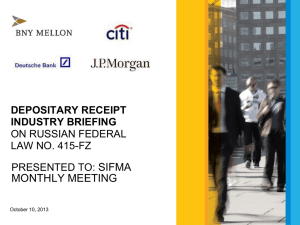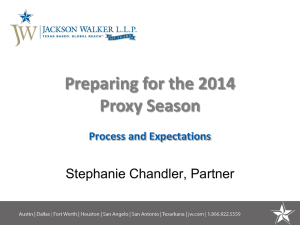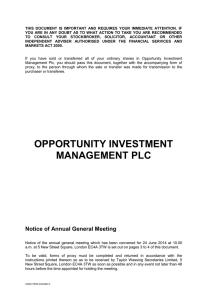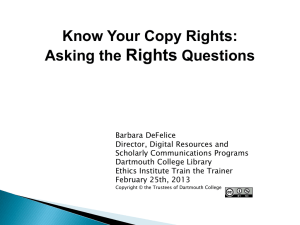Powerpoint
advertisement
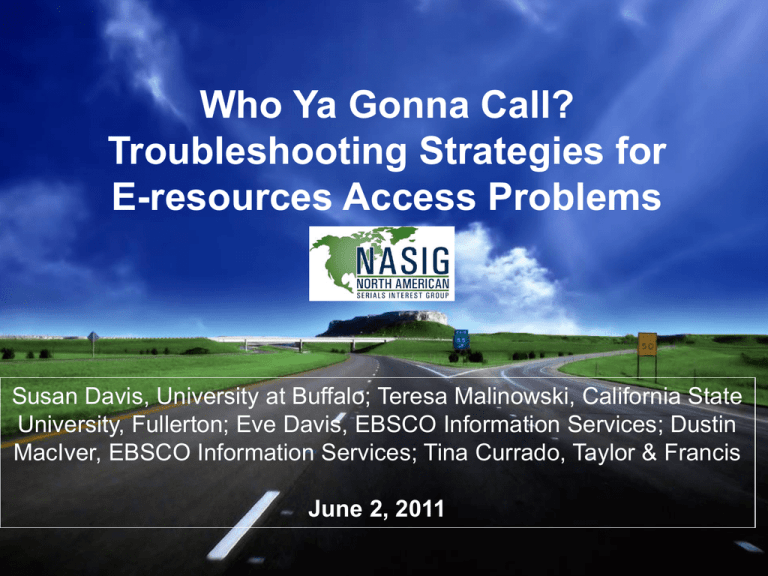
Who Ya Gonna Call? Troubleshooting Strategies for E-resources Access Problems Susan Davis, University at Buffalo; Teresa Malinowski, California State University, Fullerton; Eve Davis, EBSCO Information Services; Dustin MacIver, EBSCO Information Services; Tina Currado, Taylor & Francis June 2, 2011 Presentation Agenda E-Journal Pros: • End User Benefits • Library Benefits E-Journal Cons – Access Difficulty Common Access Hazards Scenarios • Tools of the Trade - Effective E-journal Registration and Access • Erroneous Proxy Server Integration • OpenURL Metadata Conflicts (Link Resolvers) • Access Restrictions (Embargoes, Author Rights Notices, Single User Limits, Perpetual Access) E-Journal Troubleshooting Best Practices E-Journal Pros In today’s digital age, demand for e-journals has increased exponentially. Many of today’s e-journals feature: Improved digital technology Simultaneous and remote user access Enhanced usage statistics Interactive interface features (e.g. subject terms, multimedia, language translation, bibliographic manager compatibility, etc.) Additionally, e-journals resolve the following library challenges: Print replacement costs Limited physical archive space Paper waste Physical processing requirements/resources E-Journal Cons – Access Road Hazards Along with benefits, e-journals also have their fair share of challenges, particularly when it comes to end user access. Access difficulty can manifest itself in many different ways. Users may encounter the following: User name and password prompts (the e-journal login credentials are often unknown and unavailable to end users). Subscription expiration messages or messages indicating access is unavailable for the e-journal. No full text available (absent full text button, HTML and/or PDF record). Error messages due to erroneous URLs, insufficient software/hardware or browser settings. Proxy server error messages due to improper/incomplete configuration. Like traffic jams, e-journal access hazards can stop users in their tracks from obtaining full text access. Activation - Start Your Engines! Payment received by provider Notification that access is available • Registration required • IP • License/subscription administrator • Administrative account • Sub agent may handle all steps Heading to the Finish Line Await activation Notification that registration has been accepted and access is up Internal record keeping Finish cataloging, OCLC, web page Holdings Add to link resolver (proxy update?) ERM Tools of the Trade - Effective E-journal Registration and Access You will likely need the following information to successfully register and activate access Subscription and license terms : • Subscription start/end dates • Subscription coverage and formats (includes print? other titles?) • Perpetual access rights and back file entitlement? • Simultaneous user limit? Registration or access claim required: • Account number or subscription reference # • Administrative account (establish or have user name and password) • Signed license on file What Do the Publisher’s Need? Institution’s contact name and email address Should the contact change, name and email address must be updated. Why? Because some publisher’s may send automatic updates to name on file Agent’s name and email address IP range updates and change notifications Is your IP static? If not, ask for a masked embedded URL or alternative authentication methods (Athens, Shibboleth, etc.) E-journal Registration and Access Best Practices • Utilize all the services and tools your subscription agent has to offer. Theystaff may • Foster collaboration between library • be Indicatetofull text types (HTML, activate access if youPDF) provide andable your proxy server administrators. • them Utilize subscription agent for assistance with administrative contact, • Sign up forIP, publisher/vendor with registration authentication. platform account and numbers et al). listserv/communications and(Ingenta direct these • communications Use a tool like antoERM or other a group emailtools to track administrative address visible to all.metadata. Track workflowwith as appropriate (task mgr). •• Flag e-journals full text limitations • (Author Keep your IP address Rights Notices).list on file and notify vendors/publishers before they change. What is a Proxy Server? (a general definition) A proxy server is a computer between your workstation computer and the Internet. When you request a web page, the proxy server receives and processes the request. After the web page is received from the Internet, the proxy server sends the file over to your workstation computer. To the user, the proxy server is invisible. A proxy server can also act as a firewall, blocking incoming network requests from the Internet. What Does a Proxy Network Look Like? Depending on the network, the proxy might be part of the firewall or completely separate from a firewall. What is a URL Rewriting Proxy? URL rewriting proxy servers require no browser configuration. These proxy servers change the URLs in web pages so that requests for web pages from licensed e-resources are routed back to the proxy server, providing users with remote access to e-resources. It operates as an intermediary server between users and licensed e-resources. Users connect to the proxy, then the proxy connects on their behalf to e-resources to obtain web pages and sends the web pages back to the users. Since the proxy server runs on a machine on the library’s network, the publisher or vendor sees the requests as coming from an IP address at the library. EZproxy and III WAM are two of the most popular rewriting proxy products on the market. Erroneous Proxy Server Integration A user attempts to access an e-journal via a proxied URL on a subscribing institution’s library web page and encounters difficulty accessing the e-journal. Troubleshooting Best Practices • • • • What is the problem? The first step in diagnosing and resolving any e-journal access issue. Ask clarifying questions - they may reveal expected behavior/results. Seeing is believing – try duplicating the problem or ask user for screen captures depicting problem. Implement help/feedback form requiring the above information with contact info. Troubleshooting Best Practices (Proxy Servers) • • • • Error Messages: Is the user entering the correct proxy login credentials? Does the error message occur before or after proxy login credentials are entered? Is the error message proxy-centric or publisher/vendor-centric? Does the problem occur for other titles/resources by vendor/publisher? Troubleshooting Best Practices (Proxy Servers) • • • • Error Messages? Does the problem occur inside or outside the network? Does the problem occur during certain parts of the day – e.g. is it sporadic? Does the problem occur when using a certain browser? Does the problem occur when using certain operating systems? Proxy Server Problem Scenario 1 End User E-journal Proxy Server A user clicks an e-journal link and correctly enters her EZproxy login credentials. However, the proxy generates an error message indicating the Administrator must authorize the host name of the URL to the proxy configuration file. Proxy Server Problem Scenario 1 Root Cause: Users will get a Hostname error message when they attempt to access a resource that has not yet been set up for use by EZproxy. This happens when publisher or vendor change domain names or move content to a new host without informing the library. Or, a library subscribes to a new resource but fails to add the resource domain to the EZproxy. Fix/Prevention Plan: Ensure new resource host domains are added to your proxy configuration prior to advertising access to patrons via your proxy server. And, if a resource’s domain changes, make sure your proxy contains the updated domain. This solution can also apply to III WAM proxy servers by adding the domain to the forward table. Proxy Server Problem Scenario 2 End User E-journal Proxy Server A user clicks a proxied e-journal URL (using EZproxy) and receives the following error: “Please tell your server administrator to check messages.txt/ezproxy.msg for a MaxVirtualHosts error .” Proxy Server Problem Scenario 2 (The role of MaxVirtual Hosts) EZproxy places itself between remote users and remote web servers by creating virtual hosts that represents the remote web servers. In proxy by port, EZproxy assigns a unique TCP/IP port number (e.g. 2050) and in proxy by hostname, EZproxy assigns a unique DNS hostname such as www.somedb.com.ezproxy.yourlib.org. As EZproxy encounters URLs to other web servers that it is configured to proxy, it assigns additional virtual hosts to represent those web servers. When EZproxy creates a virtual host, it retains the information for that virtual host and restores it when EZproxy is restarted. In environments with a large number of databases, this can lead to the need for hundreds of virtual hosts. If EZproxy reaches the MaxVirtualHosts limit, it is unable to proxy any additional web servers. Proxy Server Problem Scenario 2 Root Cause: EZproxy exceeded the default MaxVirtualHosts limit. Fix/Prevention Plan: You (or the EZproxy Administrator) should log into EZproxy Administration and validate EZproxy has established virtual hosts only for web servers used by your database vendors (and to remove orphaned hosts or hosts not used in the last 30 days). Next, edit the configuration file and look for any lines like MV 200 MaxVirtualHosts 200. MV=MaxVirtualHosts. If you have more than one such line, remove all but the last such line. If you do not have any such lines, your server is using the default of 200. To increase MaxVirtualHosts, add 100 to the existing MaxVirtualHosts value by either increasing the number on the existing line or adding a new line like MaxVirtualHosts 300. Restart EZproxy. Note: If the problem persists, you likely need to modify your firewall ports to accommodate the additional hosts. Proxy Server Problem Scenario 3 End User E-journal Proxy Server A user clicks a proxied e-journal URL (using III WAM) and correctly enters their proxy login credentials and are taken to the e-journal resource page. However, full text access is unavailable and the publisher prompts them to either log in as an institution or pay for an article despite the affiliated institution having a valid subscription to the e-journal. Proxy Server Problem Scenario 3 Root Causes: The proxy server’s IP address is not registered with the publisher or vendor. Or, the proxy prefix dropped off of the URL because the publisher redirected to another server not included in the proxy’s configuration/forward table. Possible Fixes/Prevention Plans: Ensure your proxy server’s IP address (or addresses) are registered with the publisher/vendor along with your other network IP addresses. If your IPs change, update the publisher/vendor in advance of the change. Remember to communicate publisher/vendor domain changes to your proxy administrator. Proxy Server Vendor Support EZproxy: Web site: http://www.oclc.org/ezproxy/support/default.htm Email: support@oclc.org Phone: 800-848-5800 Innovative Interfaces Inc. Customer Services: Phone: 800-878-6600 (Toll Free) Phone: 510-655-6200 or 6205 Email: helpdesk@iii.com Support Site: http://csdirect.iii.com/faq/ Innopac Mailing List: http://www.innopacusers.org/list/archives/ Proxy Server Best Practices • • • Post visible information detailing on campus/remote (proxy) e-journal/resource access protocols. Implement a user friendly error message when users enter incorrect login credentials. Advertise end user technical support contact info whenever possible. Proxy Server Best Practices • • • If applicable, indicate proxy server and resource browser/software/hardware requirements. When modifying the configuration file (EZproxy) remember to restart your proxy server to implement modifications. Foster collaboration between library staff and your proxy server administrator(s). What is OpenURL? A protocol that allows operation between an information resource, and a service component that offers localized services in an open linking environment. A URL that transports metadata or keys to access metadata for the object for which the OpenURL is provided. OpenURL servers ultimately present the end-user with context• Foster collaboration between library staff sensitive links that are dynamically configured on the basis of the and your proxy server administrators. institution's•e-collections. Such resources can include: Sign up for publisher/vendor • Full textlistserv/communications repositories and direct these • Abstracting, indexing, and databases communications to a citation group email addresscatalogs visible to all. • Online library • Flag e-journalsinwith full textarticles limitations • Citations appearing research (Author Rights Notices). • E-print systems • Other Web resources What is OpenURL? (Understanding the Jargon) Metadata – “data that describes other data” For example Aulast =Berry, Aufirst=David Source – An online service from which a patron selects an item-level link (e.g. SID=PubMed) Target – The site or service to which a query is sent when a patron clicks an OpenURL link http://openurl.ebscohost.com/LinkSvc/linking.aspx ?genre=article&sid=GoogleScholar&atitle= Alendronate offers hope to men’s crumbling bones • Foster collaboration between library staff &title=Lancet&issn=00995355&volume=354&issue and your proxy server administrators. =9186&spage=1270&date=1999&aulast=Newman • Sign up for publisher/vendor listserv/communications and direct these communications to a group email visible to all. to EBSCOhost. Here address is an OpenURL request • Flag e-journals with full text limitations (Author Rights Notices). What Does OpenURL Syntax Look Like? http://openurl.ebscohost.com/LinkSvc/linking.aspx ?genre=article&sid=GoogleScholar&atitle= Alendronate offers hope to men’s crumbling bones&title=Lancet&issn=00995355&volume=354&issue=9186&spa ge=1270&date=1999&aulast=Newman The first part of the URL is the Base URL. The Base URL is the OpenURL server target. http://openurl.ebscohost.com/LinkSvc/linking.aspx ?genre=article&sid=GoogleScholar&atitle= Alendronate offers hope to men’s crumbling bones&title=Lancet&issn=00995355&volume=354&issue=9186&spage=1 270&date=1999&aulast=Newman The remaining portion of the URL is the query string. The The first part of the spec is the Base URL query string contains the journal and article metadata and where the request origin. OpenURL Metadata Conflicts (Link Resolvers) A user at an academic library attempts to access an e-journal article via an OpenURL link resolver. When they link to the publisher’s page, they receive a “journal not found” message. • journal Fosteris collaboration library However, the indexed in between full text on thestaff publisher’s proxydefeated, server administrators. site. Frustratedand andyour feeling the user exits the • Sign uprealizing for publisher/vendor publisher’s site never full text was available for their listserv/communications and direct these article. • communications to a group email address visible to all. Flag e-journals with full text limitations (Author Rights Notices). OpenURL Metadata Conflicts (Link Resolvers) Possible Root Causes: Is the article from a supplement issue? There is currently no industry standard for indexing supplemental metadata (e.g. • vs. Foster collaboration between library staff S1 vs. Sup1 Sup-1). and your proxy server mismatched administrators.volume, issue Similar to supplement metadata, Signbetween up for publisher/vendor and start •pages source and target (e.g. issue 1 vs. issue 1-2 vs. listserv/communications issue1/2) can prevent and the direct articlethese from being to a group email found on the communications target site. address visible to all. The journal is no longer indexed on the publisher’s site. • Flag e-journals with full text limitations (Author Rights Notices). OpenURL Metadata Conflicts (Link Resolvers) Possible Fixes/Prevention Plans: If available, ensure the OpenURL link resolver’s search revision screen (e.g.“Refine Search” screen) option is enabled to allow users to modify metadata elements. Try collaboration between staff the removing• theFoster volume and/or issue field library data from and your proxy server OpenURL's "verify request" pageadministrators. and re-submit your search. • Sign up for publisher/vendor Confirm you are using the correct base URL – publishers listserv/communications and direct these occasionallycommunications change platforms. to a group email To minimize address broken links, visibleLink to all.resolvers commonly utilize metadata• enhancers to enrich data. (e.g. proprietary Flag e-journals with source full text limitations knowledge bases, CrossRef). (AuthorPubMed, Rights Notices). The NISO groups, IOATA (Improving OpenURLs Through Analytics) and KBART (Knowledge Base And Related Tools ) are working to improve the quality of OpenURL. OpenURL Link Resolver Best Practices • • • If enabling link resolver links on aggregator platforms,between considerlibrary the staff Foster collaboration following: and your proxy server administrators. •Sign Display for bibliographic or full up for link publisher/vendor text records? Both? and direct these listserv/communications •communications Display link using knowledge to a group emailbase collection filter? address visible to all. •FlagImplement CustomLink? e-journalsILL with full text limitations •(Author Incorporate print resources? Rights Notices). • If available, utilize resource ranking. Access Restrictions Full text access may be limited or denied to end users for a variety of reasons: Embargo: a delay in full text availability until a certain date or conditions has been met. Publisher/provider fails to turn on the right switch! • Foster collaboration between library staff Author rights notice: (aggregator platforms) full text and your proxy server administrators. unavailable dueuptofor author(s) request (Tazini vs. New York • Sign publisher/vendor Times). listserv/communications and direct these Discontinued back file access: fullemail text unavailable due communications to a group to cancellation of subscription address visible to all. (partial or complete loss). Simultaneous user/location limit: full text limitation due • Flag e-journals with full text limitations Notices). to number (Author of usersRights or location. Authentication limitations: full text limitation due to authentication protocol. Detours: Title moved to another publisher. Access Restrictions Best Practices • • • Sign up for publisher/vendor listserv/communications and forward to to a group email address. Sign up for title list change report alerts, bookmark publisher “for librarians” sites, monitor Transfer http://www.uksg.org/transfer Highlight e-journals with potential full text access restrictions (icon). Access Restrictions Best Practices • Foster collaboration between library staff Indicate journals/resources by full text and your proxy server administrators. types (HTML, PDF). • Sign up for publisher/vendor • Understand post-cancellation access listserv/communications and direct these rights and entitlements. communications to a group email • Implement a library research 101 class – address visible to all. informed users = guaranteed usage • Flag e-journals with full text limitations which is helpful for validating renewals. (Author Rights Notices). • Library Problem Solving Workflow E-providers Link Resolver Staff Vendors Acquisitions Staff Reference Staff Library Website, Twitter, etc. START Consortia Licensing Librarian Library IT Staff E-resources Librarian Campus IT General Best Practices for Libraries Develop a team approach (formal or informal) • Roles and backup • Reference “troubleshooting” interview • Training on basic concepts and strategies Establish a group e-mail address • Acquisitions • Problem-solving • Report template Wondering if you are a team? At least be clear about who’s who and what you are.” From Overcoming the Five Dysfunctions of a Team by Dirk Davis General Best Practices for Libraries Request contact information • Ordering process • Renewal process • Annual review Provide feedback to user • Confirm receipt of problem • Explain the problem & actions underway or taken • Use your public relations skills General Best Practices for Libraries Provide feedback to e-providers/vendors • Evaluation/trial period • Point of renewal • Site changes Create documentation • Contacts • Incident tracking • Basic problems & instructions wiki/SharePoint Thank you for attending today’s presentation! • Foster collaboration between library staff • Indicate full text types (HTML, PDF) and your proxy server administrators. • Utilize subscription agent for assistance • Sign up for publisher/vendor with registration and authentication. listserv/communications and direct these communications to a group email address visible to all. • Flag e-journals with full text limitations (Author Rights Notices). Questions? Contact Us EBSCO Dustin MacIver: DustinMacIver@ebscohost.com Eve Davis: EveD@ebsco.com Taylor and Francis Tina Currado: tina.currado@taylorandfrancis.com University at Buffalo Susan Davis: unlsdb@buffalo.edu California State University, Fullerton Teresa Malinowski: tmalinowski@Exchange.fullerton.edu

